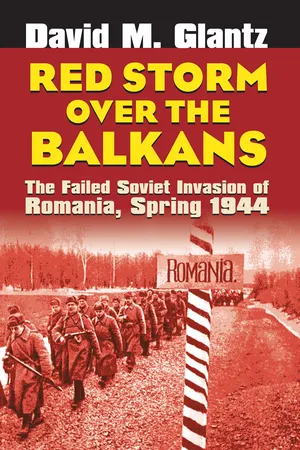
Red Storm over the Balkans
The Failed Soviet Invasion of Romania, Spring 1944
- English
- ePUB (mobile friendly)
- Available on iOS & Android
About this book
Germany’s Eastern Front in World War II saw many campaigns and battles that have been “forgotten” by a Soviet Union that tried to hide its military failures. The Red Army’s invasion of Romania in April and May 1944 was one such campaign, which produced nearly 200,000 casualties and tarnished the reputations of its commanders. The redoubtable David Glantz, the world’s leading authority on the Soviet military in World War II, now restores this tale to its proper place in the annals of World War II.
Working from newly available Russian and long-neglected German archives—plus Red Army unit histories and commanders’ memoirs—Glantz reconstructs an imposing mosaic that reveals the immense scope and ambitious intent of the first Iasi-Kishinev offensive. His re-creation shows that Stalin was not as preoccupied with a direct route to Berlin as he was with a “broad front” strategy designed to gain territory and find vulnerable points in Germany’s extended lines of defense. If successful, the invasion would have also eliminated Romania as Germany’s ally, cut off the vital Ploiesti oilfields, and provided a base from which to consolidate Soviet power throughout the Balkans.
Glantz traces the 2nd Ukrainian Front’s offensive along the Tirgu-Frumos, Iasi, and Dnestr River axes and the 3rd Ukrainian Front’s simultaneous advance to the Dnestr River and dramatic struggle to seize bridgeheads across the river and capture Kishinev. He discloses General Ivan Konev’s strategic plan as the 2nd Ukrainian Front prepared its Iasi offensive and fought a climactic battle with the German Eighth Army and its Romanian allies in the Tirgu-Frumos region in early May, then the regrouping of General Rodion Malinovsky’s 3rd Ukrainian Front for its decisive offensive toward Kishinev, which aborted in the face of a skillful counterstroke by a threadbare German Sixth Army. Glantz describes how the Wehrmacht, with a nucleus of survived combat veterans, was able to beat back Soviet forces hampered by spring floods, while already fragile Soviet logistical support was further undermined by the Wehrmacht’s scorched-earth strategy.
Although Konev’s and Malinovsky’s offensives ultimately failed, the Red Army managed to inflict heavy losses on Axis forces, exacerbating the effects of Germany’s defeats in the Ukraine and making it more difficult for the Wehrmacht to contain the Soviet juggernaut’s ultimate advance toward Berlin. By re-creating this forgotten offensive, Glantz commemorates a rich and important chapter in the history of a war that brought down the German Army and reshaped the map of Europe.
Frequently asked questions
- Essential is ideal for learners and professionals who enjoy exploring a wide range of subjects. Access the Essential Library with 800,000+ trusted titles and best-sellers across business, personal growth, and the humanities. Includes unlimited reading time and Standard Read Aloud voice.
- Complete: Perfect for advanced learners and researchers needing full, unrestricted access. Unlock 1.4M+ books across hundreds of subjects, including academic and specialized titles. The Complete Plan also includes advanced features like Premium Read Aloud and Research Assistant.
Please note we cannot support devices running on iOS 13 and Android 7 or earlier. Learn more about using the app.
Information
Table of contents
- Front Cover
- Half Title
- Title Page
- Copyright Page
- Contents
- List of Illustrations
- Preface
- 1. Introduction
- 2. Prelude
- 3. The 2nd Ukrainian Front’s April Offensive (8–23 April 1944)
- 4. The 3rd Ukrainian Front’s Advance to the Dnestr River and the First Bridgehead Battles (11–25 April 1944)
- 5. The 2nd Ukrainian Front’s Preparations for the Iasi (Tirgu Frumos) Offensive (24 April–1 May 1944)
- 6. The 2nd Ukrainian Front’s Iasi (Tirgu Frumos) Offensive (2–8 May 1944)
- 7. The 3rd Ukrainian Front’s Plans and the German Sixth Army’s Counterstrokes along the Dnestr River (2–30 May 1944)
- 8. Denouement (30 May–6 June 1944)
- 9. Conclusions
- Appendix: Soviet Documents
- Notes
- Selected Bibliography
- Index
- Back Cover